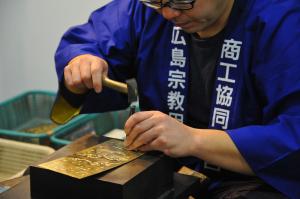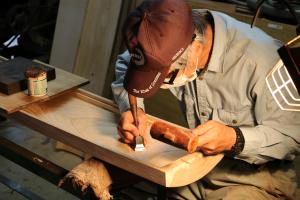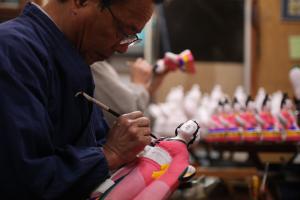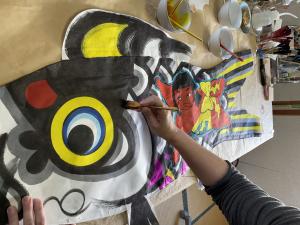The Traditional Crafts of Hiroshima
The Traditional Crafts of Hiroshima
Hiroshima Prefecture’s traditional crafts are as varied as the regions that nurture them. In the south, the Prefecture faces the countless islands that dot the Seto Inland Sea. In the north, Hiroshima is enfolded in the mountains of the Chugoku Range, blessed by a mild climate that varies gracefully with the seasons.
In the midst of this bountiful natural beauty, numerous traditional crafts are raised, spread and passed down through generations. Crafted from natural materials by accomplished artisans, these traditional products convey the warmth and kindness of the people who made them.
Honed to perfection by generations of craftspeople, these crafts have evolved along with the uses to which they are put, yet the assured technique, attention to detail and patient craftsmanship of the artisans who make them are unaltered by the passage of time.
・Hiroshima Traditional Craft Buddhist Altar
・Miyajima Crafts (Miyajima bori・Rice scoop)
・Fukuyama koto (Japanese harp)
・Takamori-e Lacquerware / KINJO Ikkokusai
・Japanese “Dōchū” Copperware(DOCHU)
・Miyoshi Dolls (MIYOSHI NINGYO)
・Togouchi Wood Hollowing (TOGOUCHI KURIMONO)
・Togouchi Woodturning Crafts(TOGOUCHI HIKIMONO)
・Traditional Woven “Bingo Gasuri” Cotton Fabric
・Hiroshimahari (Hiroshima Needle)
・Tatara Steelmaking and Katana
Return to list of exhibition themes
KUMANOFUDE
(KUMANOFUDE Traditional Craftsmen's Association)
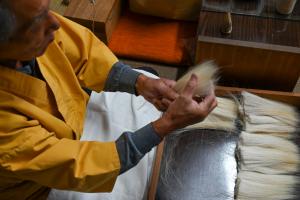
The origin of KUMANOFUDE® dates back to the end of the Edo period. During the agricultural off-season, farmers have migrated to work, bought brushes and ink from the Kinki region, and come back while peddling on the Sanyo Street. After that, brush making was introduced to Kumano, and gradually brush making flourished in Kumano as well.
In 1975, KUMANOFUDE® was designated as a national traditional craft, and the techniques and traditions have been passed down to the present day, and various brushes such as calligraphy brushes, painting brushes, and makeup brushes are produced in Kumano. It is said that about 2,500 out of about 24,000 residents are involved in making brushes. The town has become one as a production area and is working on making brushes, and now it is the number one production area for brushes in Japan.
The series of processes of sorting hair, thinning out unwanted hair, and carefully and evenly mixing various hairs to create the tip are done manually by skilled craftsmen. KUMANOFUDE® are supported by beautiful craftsmanship, with attention to detail down to the tip of each hair. Especially, the technique of “Traditional Craftsman” is amazing. A “Traditional Craftsman” is a person with an advanced skills and a long-term experience in making brushes. There are fifteen (15) KUMANOFUDE Traditional Craftsmen, who are officially designated by the Minister of Economy, Trade and Industry.
- Click here for details(external website)
HiroshimaTraditionalCraftBuddhist Altar
(Hiroshima Religious Implements Commerce and Industry Co-op)
In gratitude to Buddha : beauty born from traditional techniques
This traditional craftwork is the culmination of the work of seven different traditional master craftsmen needed to complete a single Hiroshima Buddhist altar. With praise for its coating and gold-leaf techniques, the gloss of the heavy black lacquer adds a dignified sophistication while the gold leaf brings warmth and tranquility, and the intricate carvings will leave you in awe of the beauty of Japanese aesthetics.
Designated a Traditional Craftwork by the Ministry of Economy, Trade, and Industry in 1978.
- Click here for details(external website)
MiyajimaCrafts(Miyajimabori・Rice scoop)
(Miyajima Crafts Association)
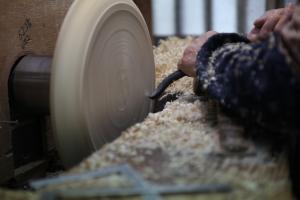
It is said that Miyajima carvings were transmitted to Miyajima in the late Edo period by NAGII Shosai from Koshu (present-day Yamanashi Prefecture).
It is carved using the base of wood, and is often made of horse chestnut, zelkova, cherry blossom, etc., and is carved using Miyajima crafts with elaborate artistic techniques such as trays and confectionery bowls made by potter's wheel molding, square trays made with cutting techniques, and finger things as the base to further increase added value.
It is said that around 1790, SEISHIN, a monk living in Miyajima, thought of it as a souvenir for the town and taught him how to make it. From around the middle of the Meiji era, it was shipped to the Kansai area as a daily item. In addition to the cleverness of the choice of materials and technology, and the gentleness of the shape that imitates the biwa, it is said that there is no odor and does not easily stick to rice grains, and it boasts the largest production volume in the Japan for its good quality.
Fukuyama koto (Japanese harp)
(Fukuyama Association of Traditional Instrument Manufactures)
Fukuyama City is Japan’s leading production area of koto, a harp-like stringed instrument. Koto production in Fukuyama began in the early years of the Edo period(1603-1868). Skilled craftsmen use paulownia wood of the highest quality to create koto. They are highly praised for their elegance and for the beautiful tones.
- Click here for details(external website)
KAWAJIRI FUDE
(Kawajiri Brush Business Cooperative)
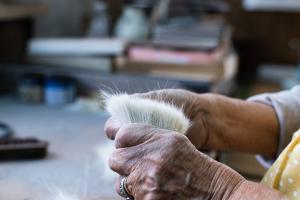
Winner of the 2014 Good Design Award.
Kawajiri writing brushes are made in Kawajiri-Town, a district of the Kure City. Their origins trace back to the late Edo period (mid-19th century), when UENO Yaekichi began producing brushes here. Drawing on the brush-making traditions of Kyoto, these brushes with their supple tips are well suited to the precise strokes required for sosho (a highly cursive style of Chinese-character writing), the kana syllabary and nihonga (Japanese painting).
Each brush is crafted by a single artisan from start to finish, using a hair-mixing technique called nerimaze. While this process does not lend itself to mass production, the advanced skill it requires results in finished writing brushes of exceptional quality.
- Click here for details(external website)
Takamori-e Lacquerware / KINJO Ikkokusai
(Kinjo Ikkokusai)
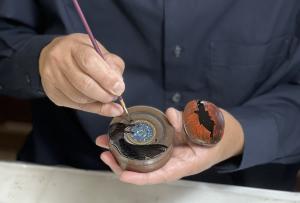
Takamori-e is created with unique techniques not often found in the world of Japanese lacquer art. This over 180 years old technique uses lacquerware or unpainted wood as a base; artisans layer lacquer to create 3D designs of flowers, bugs, and more, and then add colored lacquer to bring the detailed designs to life. The glossy lacquer is not only colorful, but also embellished with gold and silver for a stunning shine. One of the distinct characteristics of this lacquerware is how it portrays the softness of a painting and the hardiness of a sculpture all at the same time. Takamori-e techniques are passed down to one successor per generation: the works of the current Ikkokusai (7th generation) are brilliant representations of seasonal Japanese aesthetics, using styles which have been inherited from the very first.
- Click here for details(external website)
Japanese “Dōchū” Copperware(DOCHU)
(ITO Kyuhodo Co.,Ltd.,HIKARI Co.,Ltd.)
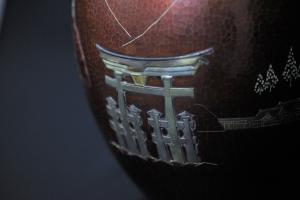
“Dōchū” (which translates to "bronze insect") was named after the coppersmith SASAKI Denbei who worked for the Lord ASANO of Hiroshima during the early Edo period. The devoted coppersmith was so dedicated to his work that he was nicknamed "the copper bug" as he would be hard at work shaping copper sheets with a mallet, decorating the beaten copper with a "tsuchime" pattern (a traditional Japanese "hammered" surface pattern), which would then be smoked with straw and polished in a way that would deepen in color and become more lustrous as time goes by.
- Click here for details(external website)
Miyoshi Dolls (MIYOSHI NINGYO)
(MARUMOTO Takashi)
Said to have been made since the Edo period, Miyoshi dolls are crafted from clay that is baked and colored with a unique luster and brightness, giving them the alternative name "hikari ningyo" ("light (shining) dolls").
There are about 140 types of dolls including female dolls and male dolls. The most well-known Miyoshi doll figure is modeled after "Tenjin", the deified spirit of the Heian period scholar, poet, and politician, SUGAWARA Michizane, who is revered in Shinto as the patron god of learning. To celebrate a child's first year of life, a custom known as "Hatsuzekku," a Miyoshi doll is gifted to children on this special occasion to pray for their growth and good health. This tradition has been widely practiced in the northern part of Hiroshima Prefecture since the Edo period and continues to this day.
Miyajima osuna pottery
(Taigendo)
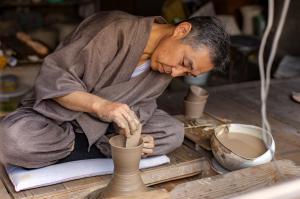
The beginning of Miyajima’s osuna pottery dates back to the Edo Period (1603 – 1863). During this time, the people of Aki (present-day western Hiroshima) collected the sand from under the Main Shrine at Itsukushima as a good luck charm for safe travels before setting out on their journeys. When they returned, they mixed the original sand with sand from their destination and returned double the amount to the Main Shrine in a tradition known as osuna-gaeshi, or ‘returning the sand’. During this period, the sand from beneath the Main Shrine was blended into clay and turned into special pottery used in religious festivals at Itsukushima Shrine. This pottery was called shinsha-yaki, or osuna-yaki (osuna pottery).
- Click here for details(external website)
Togouchi Wood Hollowing (TOGOUCHI KURIMONO)
(Togouchi Wood Hollowing YOKOHATA Crafts)
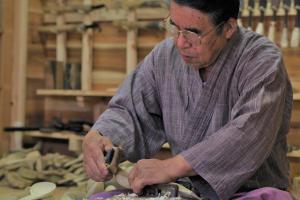
"Kurimono" (the art of hollowing out a block of wood using a carving tool), is a traditional technique said to have originated from Miyajima-zaiku (Miyajima Traditional Crafts Center), which was founded by FUJIYA Daisuke in the late Edo period. In the early Taisho period, FUKUDA Rikichi moved from Miyajima to Togouchi-cho (present-day Akiota Town in Yamagata District), where he had access to materials and passed down his techniques.
Handmade ladles carved with chisels, woodworking planes, willow knives, and other traditionally utilized tools are lovingly referred to as "fujō otama" ("floating ladle," so named due to the nature of the material which keeps it afloat in water so it does not sink when dropped into a pot).
- Click here for details(external website)
TogouchiWoodturningCrafts(TOGOUCHIHIKIMONO)
(Atelier SHINTAKU)
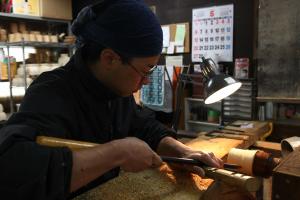
Togouchi Hikimono was established when ISHIDA Tomitsugu, who moved from Shimane Prefecture to Togouchi Town (present-day Akiōta Town in Yamagata District) during the mid-Meiji period, passed down his knowledge of woodworking and lacquering techniques. The thriving lacquerware business at the time was carried out under the division of labor between woodworkers and lacquer painters. Woodturning crafts are created by spinning wood on a “rokuro” (a “lathe” which is a machine tool that rotates a workpiece on an axis, similar to a pottery wheel) and careful knife-carving, and sometimes a coating of lacquer can be applied as a finishing touch. The sharpness of the blade produces a beautifully smooth and polished brilliance.
- Click here for details(external website)
TraditionalWoven“Bingo Gasuri” Cotton Fabric
(Bingo Gasuri Association)
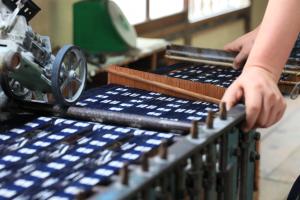
About 160 years ago (in the late Edo period), the first Bingo Gasuri (dyed cotton fabrics with special woven patterns) were produced in the Bingo region of eastern Hiroshima Prefecture (in present-day Fukuyama City) started by TOMITA Kyuzaburo.
Initially considered a small family side business, by the 1950s with the advancement of mechanization and progress of division of labor, the weaving of Bingo Gasuri flourished into a booming local industry.
At the height of its popularity, the Bingo region accounted for 70% of the nation's total production of "kasuri" (dyed patterned fabric). Along with "Kurume kasuri" and "Iyo kasuri" textiles, the "Bingo Gasuri" technique became known as one of Japan's "three major kasuri." Kasuri is a dyed woven fabric that is made by bundling warp or weft threads, tying the patterned parts with threads, and coloring them with dyes such as indigo. The woven threads become the base of the pattern, and by weaving the warp and weft yarns, a variety of patterns can be made.
Bingo Gasuri is carefully made through more than 20 processes, all of which have been handed down to the present day due to the sincere dedication and enthusiasm of skilled craftsmen.
- Click here for details(external website)
Hiroshima Carp Streamers
(Hiroshima Koinobori)
Hiroshima carp streamers carry on the tradition of hand-painted streamers made with washi paper. The warmth of washi paper, combined with the charming painting of bright and lively colors put our hand-painted streamers in a league of their own as one of the last remaining handmade streamers in all of Japan.
- Click here for details(external website)
Hiroshimahari (Hiroshima Needle)
(Bankoku needle mfg.co.,ltd.,Tulip Company Limited)
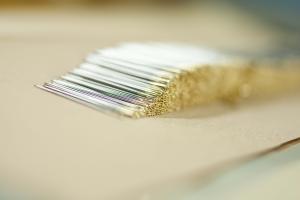
The history of “Hiroshimahari” (Hiroshima Needle) production stretches back over 300 years, to when the ruling ASANO Clan of Hiroshima Domain spread the practice as piecework for low-ranking samurai to support themselves. Since then, there have been numerous improvements in terms of both product quality and production efficiency and Hiroshimahari has become widely known as a distinctive local industry. During the Edo Period, a region called “Kake” (in the present-day of Akiota town in Yamagata District) , about 50 kilometers upstream from Hiroshima Bay along the Ota River, in the heart of the Chugoku Mountains was known as the Geihoku Region’s own“center for the Tatara (method) iron-making”rivaling Izumo, which is also part of the Chugoku Mountain’s great iron sand producing region.
The Kake Region achieved great prosperity through the use of water transport on the Ota River to bring in necessary materials and supplies from around Japan while also serving as a center for transporting iron produced through “the Tatara (method) iron-making”to Hiroshima. In the same way, Hiroshimahari production developed through shipping this“Tatara”iron, which was made using iron sand from Kake, on the Ota River to the present-day City of Hiroshima, where it was processed into needles.
- Click here for details(Bankoku needle mfg.co.,ltd.)(external website)
- Click here for details(Tulip Company Limited)(external website)
TOHOBEADS
(TOHO CO.,LTD.)
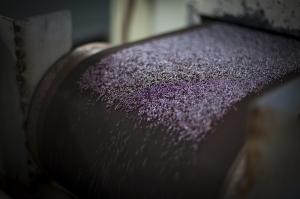
TOHOBEADS is the finest manufacturer of glass beads in Japan and we are proud of best quality and quick delivery.
TOHO means “Eastern Treasure” in English. We put the wish and named TOHO to our company for the small glass beads might be called “Eastern Treasure”.
- Click here for details(external website)
Hiroshima Lacquerware
(Lacquerware artist TAKAYAMA Naoya)
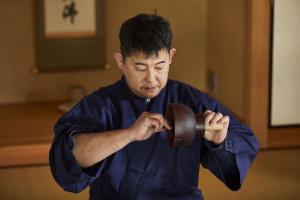
This shuki-style ewer, called ‘Yoi,’ is made of cloth overlaid with lacquer glue since wood cannot be shaped into a smooth, streamlined spout. This technique, known as the dry lacquer method, or Kanshitsu in Japanese, is light, thin, and durable.
The outer surface was inspired by the imagery of dusk: that moment when the day is over and the sun is setting. A technique known as Tame-nuri was used, whereby layers of transparent lacquer are applied. The name 'Yoi' was chosen for this ewer as its pronunciation echoes the Japanese words for 'twilight’ and 'drunkenness'. The lacquer dries over 50 years, gradually becoming tighter whilst maturing into a lustrous and elegant product.
- Click here for details(external website)
TataraSteelmakingandKatana(HiroshimaSwordsmithingAssociation
(MIKAMI Sadanao’s katana forging dojo)
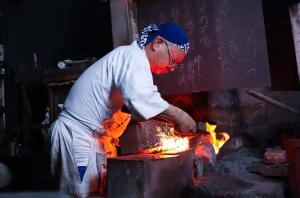
Katana are a rare artistic handicraft. They are created by forging tamahagane, a traditional Japanese steel made from ironsand, using a traditional Japanese steelmaking technique called tatara. In this technique, layers of hard and soft steel are forged together and then quenched. The resulting swords are painstakingly ground into a blade with a finely tempered pattern and surface. Today anime featuring famous swords as heroes are booming, attracting growing ranks of young female fans.
The Chugoku Range, which includes northern Hiroshima Prefecture, boasts a history of over 1200 years as a producing region of ironsand, the raw material for tamahagane. Until the introduction of blast-furnace steelmaking 130 years ago, this was Japan’s biggest steelmaking region. Today, to support Japanese steelmaking techniques in just one remaining location, the Okuizumo Town in Shimane Prefecture carries on the traditional practice of making tamahagane using ironsand and charcoal.
The men who made the swords exhibited here, MIKAMI Sadanao and KUBO Yoshihiro, are two of Japan’s most distinguished craftsmen, certified as Hiroshima Prefecture Holders of Intangible Cultural Properties. MIKAMI also serves as acting murage (chief engineer), and KUBO once worked alongside him.
- Click here for details(external website)


